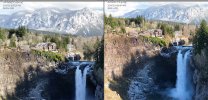If those were individual frames exported from a timeline I would not be entirely shocked to learn that the very minor difference in sharpness might be due to movement of the camera during the capturing of the frame. The drone is not sitting perfectly still on a tripod so I would expect some minor variation in terms of sharpness from one frame to another. Even if you looked at 10 or twelve frames it would be hard to judge, not knowing if a minute earlier the wind was more or less strong the the drone was more or less stable. The difference in sharpness is, after all, pretty minor. I don't dismiss the possibility that the 120fps image shot by your drone is indeed a bit less sharp but one frame doesn't tell us that definitively. To my way of thinking it would take a fair bit more testing to say that the 120fps is not as sharp - at least from simple observation - since nobody has piped in here with the bit rate of 120 vs 60. The
M3 manual states that the bitrate for H264 is 200Mbps and for 265 it is 140 so I would expect to see some difference there but I wouldn't expect different bit rates for the two fps variations. I'll be interested to learn what others have to say although the difference between the two, for my purposes, is negligible.














